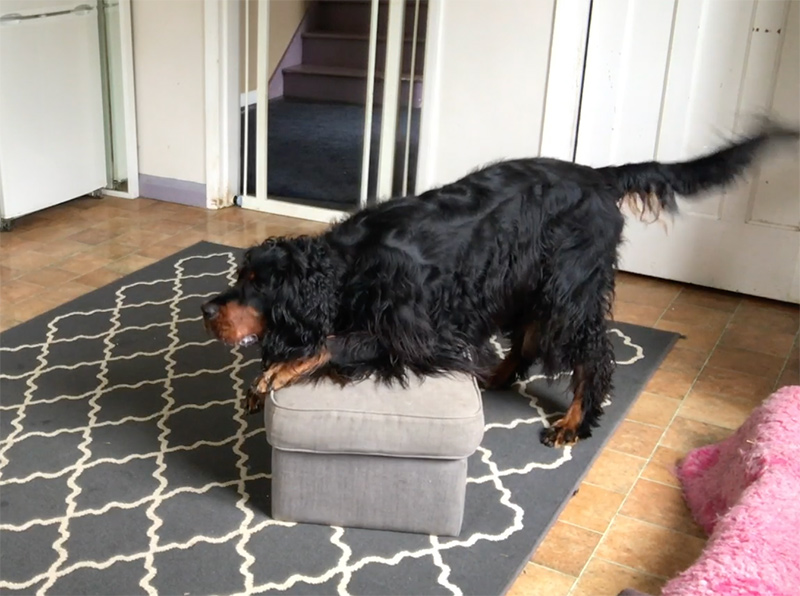The Power of A Cue

The power of a cue ….
I recently posted this video to FaceBook which harks back to those early, discovery days of clicker training. We cannot presume a cue is a reinforcer unless we can shape a new behaviour using that cue as the marker. This is how it unfolds …..
Merrick is experiencing a demand for finding a solution, and when successful I am using the cue “turn” as the marker. This is not as accurate as a click, but it demonstrates the power of a cue.
Sarah Owings posted this response to the video The Power of Cue (Aug 2018)
“Do you feel that there is a time and place for trainers to deliberately leave space for dogs to do this kind of problem solving? The current trend is to keep the loops so tight, with micro-reinforcement delivery each step of the way. Although you can get much closer to errorless that way, also seems much less room for thinking.”
It is always a bit spooky when brains are shoved in the same direction by a single event. I only write this yesterday after posting the video: Construction or suppression?
I don’t think the question is whether the protocol is the right choice or the wrong choice but how the learner behaves. Just as a protocol cannot be good or bad since its success is completely dependent on skill level and motivation – much like cooking. A recipe “fails” because of application or variation in the ingredients.
In my video I see a relationship that is a two-way conversation. It is Merrick working hard to get me to respond. I see she quite enjoys that process, and the frustration of me pretending to be unimpressed causes her to flirt even more.
This is part of her personality.
I am self-limiting in what I will teach a particular dog through only exploring and expanding on behaviours that exist naturally for that dog. She has never shown any sign of crawling across the floor, standing on her front legs and rarely sits. So I do not teach her these behaviours. My collies have never shown the chin-to-floor-butt-up, and is not only a Gordonish behaviour but it is a product of a very, very flexible spine and shoulder angles.
The behaviours I select to build are already in her own repertoire to some degree. The turn-spin you see is one of her favourite expressions of anticipation.
The same limitation can then be applied to whether the dog naturally enjoys the processes, or teaching strategies we use and whether they have the skills and experience for them.
I remember finding it extremely unmotivating to be faced with a blank sheet of paper and instructed to “create something”. Either essays, poems, pictures or doodles.
But one art teacher used to read a paragraph from a book and then gives us the paper. That worked fine for me. I think it is called “reactive blogging” these days. Imagination or response is stimulated by the environment. For the dogs it would be the placing of a new object instead of a paragraph.
That strategy connected with my learning style, it was in my repertoire, at that age.
There is a chronological component to also be considered. A naïve or novice learner that has low self-esteem should never be put in this situation. Would I have done this with her as a puppy? Absolutely not, thinking processes were super hard, which was normal for her stage of development.
The creativity, confidence and her relationship with me, develop with time.
I would like to think, my plan for her education to develop this “thinking capacity” came as a result of the micro-shaping, the protection from errors, the building of her learning experiences.
I like this:
You are not a blank slate, nor a receptacle to be filled.
I am not the font of all knowledge, not the pen that will write the answers across your mind’s sky.
Read carefully, think carefully, consider multiple perspectives.
Weigh the evidence, check the sources, ask questions.
Charlotte Pezaro.
If a learner has not had the opportunity to learn how to;
~ read carefully
which is usually the skills of reading between the lines, assessing exactly what the question is asking, following the instructions in detail
~ think carefully
develop a process of teasing apart the points, consider how those would affect individuals, preparation required before application
~ consider multiple perspectives
in training the perspective of the animal, their future, the skills they will need for the life for which they will be living
Have they learned how to weigh evidence?
Rarely, it seems if someone has done it on Facebook or YouTube then that constitutes “evidence”. Even an expensively produced TV show is biased to entertain and will mostly skip the educational authenticity completely.
Sources need to be checked. Some of the original interpretations of the early days, were just that, an opinion of one person or one institution. The example “click and treat”, no, it is “click and reinforce”, but that misinformation took a long time to turn around. “Premacking” has become a common place verb and being ascribed to anything that is not a piece of food.
This is, for me, poor examples of the educational diligence which people are avoiding when it comes to animal training and their own learning. It seems easier to let someone else do the thinking for you and just copy.
If we want to go a step further I would set an exercise – a discussion beginning with Pezaro’s excellent article about Conferences. For every point she makes we have similar issues within the training community and professions. https://www.charlottepezaro.com/blog/fourquestions
I feel a FB group coming on: “The Education of …. ???”









0 Comments